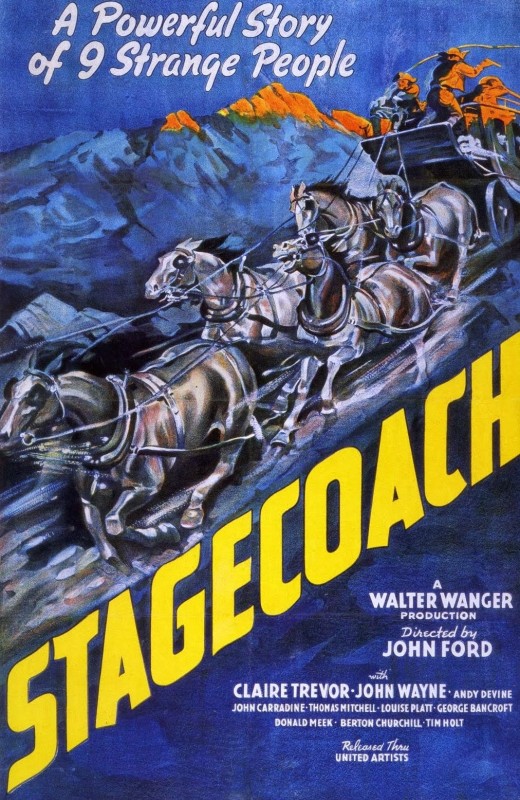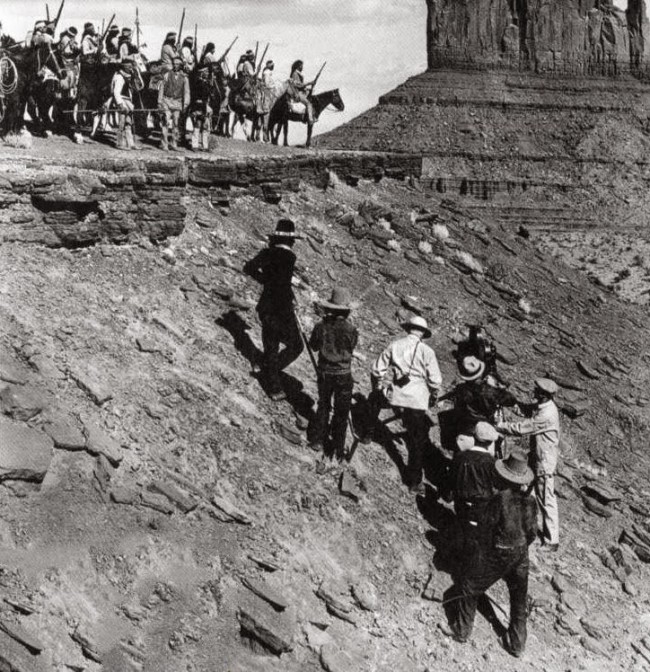I recently wrote a post about the year 1971, a year that I regard as the best year of movies ever and I received an overwhelming number of responses offering 1939 as its chief rival. As a complete fanatic for that year of movies, I could offer little in response other than total agreement that I regard 1939 to be the high water mark of what we think of as the Golden Age of Hollywood. 1939 is the year that many, myself included, regard as the year that Hollywood finally reached its zenith before entering a period of gradual decline. This is the year where both “Gone With the Wind” and “The Wizard of Oz” were unleashed on the public’s imagination. While not my favorite films at all from that year, no one can deny the enduring popularity of those two films to this very day. In 1939, the glamor of old Hollywood was in its prime with a treasure trove of movie stars with contracts at all the major studios but even more important was the influx of European actors, directors and technicians seeking to avoid the horrors of Nazi Germany. For a few years, the greatest filmmaking talent in the Western hemisphere from Jean Renoir to Fritz Lang to Luis Buñuel was all gradually migrating West to work in Hollywood. For film history buffs, the Hollywood of 1939 resembles Camelot as described by T. H. White in “The Once and Future King”, but it was only a matter of time before that state of grace began to fade.
Once the US entered World War II, the Hollywood community changed forever with a wide array of its best talent, male and female alike, enlisting in the war effort. Sadly, in the years after the war, post-war paranoia about communism forced the creative community to draw battles lines resulting in many actors and filmmakers being blacklisted for their political sympathies and ideologies. Another major factor in the death of old Hollywood was the Hollywood Antitrust Case of 1948, otherwise known as the Paramount Decision, where the Supreme Court prohibited movie studios from owning their own theater chains thereby destroying the vertically integrated system that Hollywood had enjoyed for so many years. Although movie theater attendance continued to rise until its peak in 1946, the final nail in the coffin in the Golden Age was the arrival of television which had a devastating impact on movie theater ticket sales in the years to come. The Golden Age was over but for sentimental fools like myself, 1939 is a year of filmmaking that seems to glow brighter all the time. There are so many classic from that year, many of which I still look forward to seeing for the first time. So without further rambling on my part, here are my favorite movies from 1939 listed in no particular order.
Stagecoach
John Ford had a busy year in 1939 with his films “Young Mr. Lincoln” and “Drums Along the Mohawk” both of which could have easily made this list, but I have to go with “Stagecoach”, a movie I have revisited more times than I can count. I was lucky enough to catch this movie in a film class at UVA when I was 20 years old and I can vividly remember a friend of mine saying as it ended that he wouldn’t mind watching the movie all over again then and there. Ford was already an incredibly prolific and successful filmmaker prior to “Stagecoach” with movies like “Judge Priest” (1934) and “The Informer” (1935) but with “Stagecoach” he began the legendary phase of his career that led to masterpieces such as “The Grapes of Wrath” (1940), “How Green Was My Valley” (1941), “My Darling Clementine” (1946), “Fort Apache” (1948), “She Wore a Yellow Ribbon” (1949), and my favorite of his, “The Searchers” (1956). Looked at from any angle, “Stagecoach” is a masterful film and deliciously entertaining. While preparing to shoot “Citizen Kane” (1941), Orson Welles would screen the film on a nightly basis with different crew members in order to learn as much as possible about the different facets of film production. The cast is so good they will make your heart ache but the most important bit of casting involved the Duke. “Stagecoach” officially announced the arrival of John Wayne as one of the biggest stars the town had ever seen. Whether you’re a fan of Westerns or not is immaterial, this film is one of the essentials for anyone claiming to be a moviegoer.
The Rules of the Game
While Hollywood was enjoying an age of glamour and success that would never again be equaled, over in Europe the threat of a new World War cast a shadow over the entire continent. Jean Renoir, son of the painter Pierre-Auguste Renoir, had already established himself as a major filmmaker with films such as “La Chienne” (1931), “Boudu Saved from Drowning” (1932), “A Day in the Country” (1936), and “La Grande Illusion” (1937). With “The Rules of the Game” he turned his eye on every level of French society, a society that he felt was disintegrating. With “The Rules of the Game” Renoir created a sublime comedy of manners that skewers both the French aristocracy and those who work for them. The most expensive film ever made in France at that time, the film was a resounding flop that was banned by the French government for having “an undesirable influence over the young.” Jean Renoir would soon make his move to Hollywood where he made many fine films such as “The Diary of a Chambermaid” (1946). Thankfully “The Rules of the Game” survived being recut and seemingly lost for many years before its rediscovery and restoration in 1956. We can now appreciate Renoir’s masterpiece for the amazing film that it is.
Only Angels Have Wings
Howard Hawks is one of my favorite directors and it pained me when he did not make my 1971 list due to his last movie being released in 1970. Thankfully in 1939, he was firing on all cylinders. He had already earned a place in the history books with “Scarface” (1932), “Twentieth Century” (1934), and “Bringing Up Baby” (1938), but with “Only Angels Have Wings” he was able to tackle one of his favorite subjects, one that he would explore in several films, flying. Hawks was a flight instructor during WWI and he understood the dangers of flying on a personal level. His brother Kenneth was killed in a plane crash in 1930 while directing aerial photography for the film “Such Men are Dangerous” and no film captures better the lifestyle, mentality and code of pilots in dangerous situations than “Only Angels Have Wings”. My only grievance against this movie is that Jean Arthur seems horribly miscast and doesn’t fit at all into the laconic, laid back vibe that the best of Hawks’ work enjoys. That said, Cary Grant and Thomas Mitchell are so damn good that I can easily overlook any misgivings I might have. Without question, this is one of Hawks’ best.
_NRFPT_01.jpg&container=blogger&gadget=a&rewriteMime=image%2F*) |
| “Only Angels Have Wings” director Howard Hawks with Cary Grant and Rita Hayworth |
The Roaring Twenties
Raoul Walsh doesn’t receive nearly enough attention these days. He got his start in the early days of cinema (you can see him in a cameo as John Wilkes Booth in “The Birth of a Nation” (1915)) and he eventually went on to direct well over 100 films, the majority of which he shot under the roof of Warner Bros. If the Warner Bros. logo makes you think of gritty, hardcore tales of gangsters, outlaws and cowboys, chances are you’ve seen some of Walsh’s work. Walsh’s work as a director in the gangster genre goes all the way back to an excellent early film “Regeneration” (1915) but with “The Roaring Twenties” Walsh really found his stride before continuing with classics such as “High Sierra” (1941), “Pursued” (1947) and “White Heat” (1949). “The Roaring Twenties” pairs James Cagney and Humphrey Bogart in one of the best gangster movies from a decade that yielded an almost embarrassing number of extraordinary gangster films. For me, the movie serves as the perfect closing chapter on the classic Gangster period before the arrival of film noir. I also defy anyone with a pulse not to be moved to tears by the climax that features some of the finest acting of Cagney’s career.
Ninotchka
Another director who is overlooked far too often in 2015 is Ernst Lubitsch. Master of “The Lubitsch Touch”, the German Ernst Lubitsch arrived in Hollywood in 1922 and proceeded take the city by storm. By 1935, he was appointed Paramount’s production manager, a feat unheard of by directors of that era. He arguably made the most sophisticated comedies in the history of the business, films rife with subtle sexual innuendo, leading me to wonder why tastes today have drifted so far away from his style of storytelling. Jean Renoir credited him with inventing the modern Hollywood while Billy Wilder kept a sign over his desk for years that simply said, “How would Lubitsch do it?” “Ninotchka” is one of his best films (co-written by Billy Wilder) and stars the screen goddess Greta Garbo. In this movie she finally departed from her classic “I vant to be alone” persona and actually laughed on screen, a fact that was used heavily to promote the film. A delightful comedy from top to bottom, this movie is the perfect point of entry to discovering one of greatest directors in Hollywood history.
Mr. Smith Goes to Washington
For anyone who thought I was overly dismissive of Jean Arthur earlier, here is a movie where she absolutely shines, Frank Capra’s “Mr. Smith Goes to Washington”. Cute, cuddly and wholesome have never really been my thing when it comes to cinema, however, I make an exception with Frank Capra whose work increasingly tackled the dark underbelly of society as his career progressed. With “Mr. Smith Goes to Washington” we have the classic scenario of an idealist tackling corruption head on as Jimmy Stewart comes face to face with all the soul-crushing compromises one is forced to endure in order to get anything accomplished in Washington. While my personal favorite of Capra’s work remains “It’s a Wonderful Life” (1946), “Mr. Smith Goes to Washington” should be shown to every child in America.
I’m going to wrap things up but I do want to mention other films from 1939 that I particularly admire that could easily have made this list: Marcel Carné’s Le Jour se Leve, John Ford’s Young Mr. Lincoln & Drums Along the Mohawk, George Stevens’ Gunga Din, Michael Curtiz’s The Private Lives of Elizabeth and Essex & Dodge City, George Cukor’s The Women, Victor Fleming’s Gone With the Wind & The Wizard of Oz. Sadly Charlie Chaplin, Fritz Lang, & Luis Buñuel did not release any movies in 1939 while other greats such as Billy Wilder, Preston Sturges and John Huston had not yet made the leap from screenwriter to Hollywood director. In that I’m focusing on features I also omitted the incredible work of animators such as Chuck Jones, Tex Avery, Max and Dave Fleischer and many more.
Thankfully I still have many more essential films from 1939 to track down including The Four Feathers, Destry Rides Again, Intermezzo, Alfred Hitchcock’s Jamaica Inn, Wuthering Heights, Another Thin Man, William Wellman’s Beau Geste, The Hunchback of Notre Dame, Goodbye, Mr. Chips, The Rains Came, Love Affair, Of Mice and Men, The Little Princess, The Adventures of Sherlock Holmes, Each Dawn I Die, The Hound of the Baskervilles, In Name Only, Union Pacific, Allegheny Uprising, At the Circus, You Can’t Cheat an Honest Man, Gulliver’s Travels, Henry King’s Jesse James, James Whale’s The Man in the Iron Mask, and The Cat and the Canary. If there any films from this year that I left off I would greatly appreciate any suggestions. Thank you for giving my list a look and let me know which year you find to be the greatest in movie history.
I am one of the Co-Hosts of the podcast Wrong Reel and you can find our material here:















